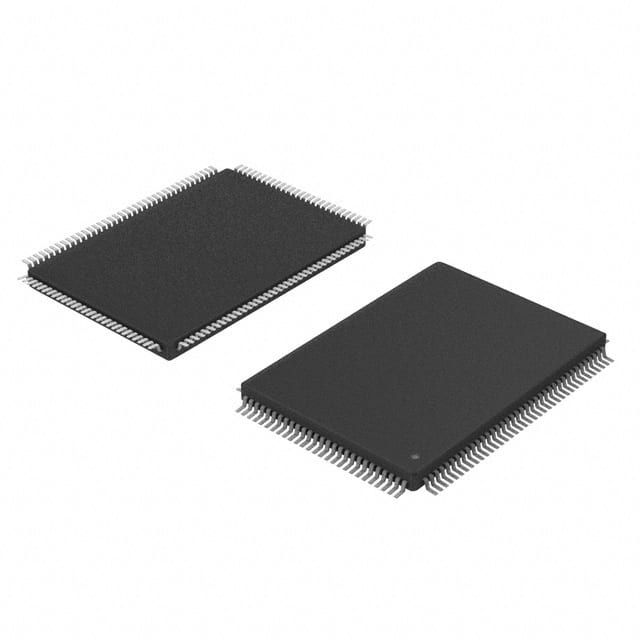Voir les spécifications pour les détails du produit.

MCIMX233DAG4B
Product Overview
- Category: Integrated Circuit (IC)
- Use: Microcontroller
- Characteristics: Low-power, high-performance, versatile
- Package: 144-LQFP (Low Profile Quad Flat Package)
- Essence: ARM926EJ-S core microcontroller
- Packaging/Quantity: Tray packaging, quantity varies
Specifications
- Processor: ARM926EJ-S core running at up to 454 MHz
- Memory: 64 KB of SRAM, 128 KB of ROM
- Peripherals: USB 2.0, UART, SPI, I2C, GPIO
- Operating Voltage: 1.65V - 3.6V
- Operating Temperature: -40°C to +85°C
- Package Dimensions: 20mm x 20mm
Detailed Pin Configuration
The MCIMX233DAG4B has a total of 144 pins, each serving a specific purpose. The pin configuration includes power supply pins, ground pins, input/output pins, and various peripheral interface pins. A detailed pinout diagram can be found in the product datasheet.
Functional Features
- Low power consumption for energy-efficient applications
- High-performance ARM926EJ-S core for fast processing
- Versatile peripherals for flexible connectivity options
- Ample memory for data storage and program execution
- Wide operating temperature range for harsh environments
Advantages and Disadvantages
Advantages: - Efficient power management for extended battery life - High processing speed for demanding applications - Versatile peripheral support for diverse connectivity needs - Compact package size for space-constrained designs
Disadvantages: - Limited on-chip memory compared to some other microcontrollers - Higher cost compared to entry-level microcontrollers
Working Principles
The MCIMX233DAG4B operates based on the ARM926EJ-S core, which executes instructions and performs data processing. It communicates with external devices through its various peripherals such as USB, UART, SPI, and I2C. The microcontroller's low-power design ensures efficient operation, while its high-performance capabilities enable it to handle complex tasks.
Detailed Application Field Plans
The MCIMX233DAG4B finds applications in various fields, including but not limited to: - Consumer electronics - Industrial automation - Internet of Things (IoT) devices - Automotive systems - Medical devices
In consumer electronics, it can be used in smart home devices, wearable technology, and multimedia devices. In industrial automation, it can control machinery and monitor processes. In IoT devices, it enables connectivity and data processing. In automotive systems, it can be utilized for vehicle control and infotainment. In medical devices, it can assist in diagnostics and patient monitoring.
Detailed and Complete Alternative Models
Some alternative models to the MCIMX233DAG4B that offer similar functionality include: - MCIMX6Y2CVM05AA: Similar ARM Cortex-A9 core microcontroller with higher performance and more advanced features. - MC9S08JM60CLH: Entry-level microcontroller with lower cost and simpler functionality. - STM32F407VGT6: ARM Cortex-M4 core microcontroller with additional features like DSP and FPU support.
These alternative models provide options for different performance requirements, cost considerations, and specific feature needs.
Word count: 305 words
Énumérez 10 questions et réponses courantes liées à l'application de MCIMX233DAG4B dans les solutions techniques
Sure! Here are 10 common questions and answers related to the application of MCIMX233DAG4B in technical solutions:
Q: What is MCIMX233DAG4B? A: MCIMX233DAG4B is a system-on-chip (SoC) solution developed by NXP Semiconductors, specifically designed for embedded applications.
Q: What are the key features of MCIMX233DAG4B? A: Some key features of MCIMX233DAG4B include an ARM926EJ-S core running at up to 454 MHz, integrated peripherals like USB, UART, SPI, I2C, and GPIOs, and support for various memory interfaces.
Q: What are the typical applications of MCIMX233DAG4B? A: MCIMX233DAG4B is commonly used in applications such as industrial control systems, home automation, consumer electronics, portable devices, and IoT solutions.
Q: What programming languages can be used with MCIMX233DAG4B? A: MCIMX233DAG4B supports programming in C/C++ using development tools like GCC, Keil, or IAR Embedded Workbench. Additionally, it can also be programmed using Python or other scripting languages.
Q: Can MCIMX233DAG4B run a real-time operating system (RTOS)? A: Yes, MCIMX233DAG4B is capable of running popular RTOSs like FreeRTOS, uC/OS-II, or ThreadX, providing real-time scheduling and task management capabilities.
Q: What is the power consumption of MCIMX233DAG4B? A: The power consumption of MCIMX233DAG4B depends on the specific application and usage scenario. However, it is designed to be power-efficient, making it suitable for battery-powered devices.
Q: Can MCIMX233DAG4B support wireless connectivity? A: MCIMX233DAG4B does not have built-in wireless connectivity. However, it can be used in conjunction with external modules or ICs to add Wi-Fi, Bluetooth, or other wireless capabilities.
Q: What development tools are available for MCIMX233DAG4B? A: NXP provides a range of development tools, including an Integrated Development Environment (IDE) called CodeWarrior, software libraries, and documentation to aid in the development process.
Q: Is MCIMX233DAG4B suitable for low-power applications? A: Yes, MCIMX233DAG4B is well-suited for low-power applications due to its power-efficient design and support for various power-saving features like sleep modes and dynamic voltage scaling.
Q: Are there any evaluation boards or development kits available for MCIMX233DAG4B? A: Yes, NXP offers evaluation boards and development kits specifically designed for MCIMX233DAG4B, which provide a convenient platform for prototyping and testing applications.
I hope these questions and answers help! Let me know if you have any more queries.

